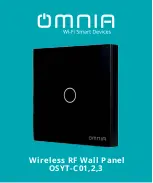
USER MANUAL
PTM 535 / PTM 535U / PTM 535J
–
ENOCEAN TRANSMITTER MODULE
© 2019 EnOcean | www.enocean.com
F-710-017, V1.0
PTM 535 / 535J User Manual | v1.5 | September 2020 | Page 14/36
3.2
Enhanced security mode
While operating in enhanced security mode, PTM 535 sends secure telegrams in accordance
to EEP D2-03-00 as specified in EnOcean Equipment Profiles. For more details refer
to
http://www.enocean-alliance.org/eep/
These telegrams include a rolling code based on an incrementing counter which guarantees
that identical message content will be encrypted differently for each telegram thus prevent-
ing replay attacks.
The initial counter value is transmitted from PTM 535 to the receiver as part of the teach-in
telegram when entering secure mode. Subsequent secure telegrams do not specify this
counter value; therefore sender and receiver have to automatically increment their respec-
tive counters for each secure telegram to keep them synchronized.
When telegrams are not received by the receiver this may lead to a de-synchronization of
transmitter and receiver counters, i.e. the transmitter counter will have a greater value
than the receiver counter.
In order to prevent failure, the receiver will usually test the received rolling code against a
defined window of future expected rolling codes and
–
if successful - resynchronize its
counter automatically. The size of this rolling code window is defined on the receiver side.
It is important that the amount of consecutive, non-received telegrams does not exceed the
side of this window.
For more details please refer to
http://www.enocean.com/en/security-specification/
The rolling code is not transmitted with every telegram. It is only transmitted dur-
ing teach-in. Afterwards the receiver has to increase the counter autonomously for
each received message.
It is strongly recommended to use PTM 535 in secure mode only in fixed installa-
tions with safe radio distance to avoid de-synchronization of sender and receiver.
De-synchronization will occur if PTM 535 is operated outside the range of the re-
ceiver consecutively more often than the size of the rolling code window defined
on the receiver.
The same may apply if consecutive telegrams are lost on the receiver side due to
power interruptions.
In these cases it is necessary to set the receiver in LRN mode and teach-in the
device again.















































